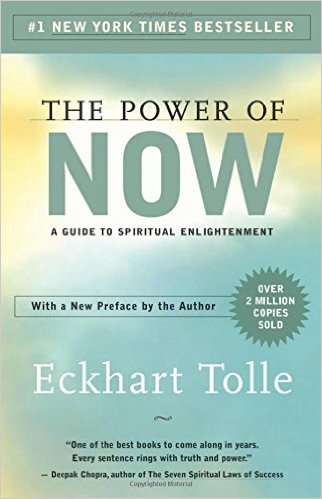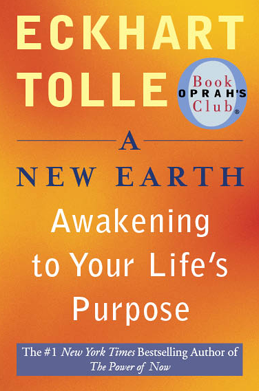|
Word Gems
exploring self-realization, sacred personhood, and full humanity
Editor's 1-Minute Essay:
Zen
return to "Zen" main-page
|
"Life and death are of supreme importance. Time swiftly passes by and opportunity is lost. Each of us should strive to awaken. Awaken. Take heed, do not squander your life."
Dogen Zenji
|

|
Editor’s prefatory note:
We are to search for, and follow, the truth wherever it leads, whatever its source. And when we find a particle of it, even in our rejoicing, we must hold it loosely in our hands – for there is always more to come. And when it comes, it will modify our current views of how the Universe works. The modification may be slight or it may be revolutionary, but, in either case, we will be changed by its advent.
“Holding truth loosely” in one’s hands, in a practical sense, means that it’s inadvisable to plant the flag as a card-carrying member of this ideology or that religious organization. How could such strict true-believer affiliation make sense? No human being, and no corporate entity, could ever become repository of any final word on the “Truth.” This is not possible. And even a million years from now we will be saying the same thing; for the more we learn, the more the horizon of certainty recedes and flees from us - an "expanding frontier of ignorance," as Dr. Richard Feynman called it. So shall it ever be.
I offer this statement as preface as some will assume, with a promotion of Zen, that I am a Buddhist. But I am not; nor do I claim wholesale affinity with any group’s party-platform or structured belief-system.
How then shall we live a godly life? Keep your mind unfettered from cultish constraint, critically evaluate and question all things, “open a channel,” allow “the Spirit” or Universal Consciousness to direct your steps, and follow the “Truth” wherever it leads.
And when you find a gold nugget, and if it passes your evaluative tests, claim it as your own. There may be a philosophical or religious group out there that has popularized what you’ve discovered, but they did not invent it. Any concept of lasting value and universal importance has existed since the beginning of time, and before, and so no one can hold exclusive title-deed to the “Truth.”
Claim it for your own, hold it loosely, though, and rejoice in your new-found riches... but, know that more is coming; there’s always more coming.
|
|
the moment of becoming a sane, really free, human being
“I'm simply saying that there is a way to be sane. I'm saying that you can get rid of all this insanity created by the past in you. Just by being a simple witness of your thought processes. It is simply sitting silently, witnessing the thoughts, passing before you. Just witnessing, not interfering not even judging, because the moment you judge you have lost the pure witness. The moment you say ‘this is good, this is bad,’ you have already jumped onto the thought process. It takes a little time to create a gap between the witness and the mind. Once the gap is there, you are in for a great surprise, that you are not the mind, that you are the witness, a watcher. And this process of watching is the very alchemy of real religion. Because as you become more and more deeply rooted in witnessing, thoughts start disappearing. You are, but the mind is utterly empty. That’s the moment of enlightenment. That is the moment that you become for the first time an unconditioned, sane, really free human being.”
Osho, Indian mystic, (1931-1990)
|
what every new person to spiritual practice must understand
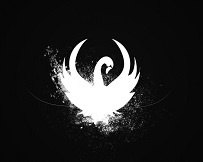
| Breakthrough: “Spiritual practice must be uninterrupted. We may be anxious because we see very little happening on a daily basis, but we must be patient… After long self-cultivation, one’s accumulated energy reaches a threshold and then bursts out, like a swan rising from the water… Once you have reached this level of stored energy, you will be a different person.” Deng Ming-Dao, 365 Tao |
|
If you tell others about “going within” and spiritual practice, most won’t believe you. Instead, they’ll opt for “I’ll become a good person by trying very hard.” However, I’ve asked myself, what convinced me early on to stay with this process, though it might take years for real change? I think it was Tolle’s explanation of the “voice in the head” and the background witnessing presence that drew me. He told his story of a late-night despair – “I can’t live with myself!” – but then recoiled with “Who is this ‘I’ and this ‘self’? Are there two of me?” This testimony impacted me greatly, and I caught a glimpse of what he had discovered. This brief introduction, I think, helped me to realize that there’s some sort of hidden life or energy in my mind and spirit that I’d been unaware of. I could feel the difference now between “the voice in the head” and the part of me that knew of its existence. These were two separate things. And I believe that it was this understanding, right at the beginning, that helped me to stay with the “long self-cultivation”, as Deng put it. It would be years before I perceived any real results. Others around me saw it before I did. But, I will say this: Once that “threshold” is attained, the “bursting” will result in a daily surfeit of insights and flashes of perception that will overwhelm. Deng is correct: at this stage, “you will become a different person.” Why does this happen? I think it’s like a tiny seed of godhood buried deep within. It wants to blossom and emerge. The key is to provide the right conditions for germination to occur. We don’t have to try to change, for once it begins in earnest, it will virtually steamroll the willing student into new thought patterns, and will change us from the inside out. Hang on to this rollercoaster, as it will take you for a ride. Others likely will not believe these words. You have to experience it for yourself.
|
|
one's personal sense of 'I Am,' on a deeper level, merges with the great 'I Am'
“If I penetrate the depths of my own existence, to the indefinable ‘I Am,’ that is, myself, at its deepest roots, then through the deep center I pass into the infinite ‘I Am,’ which is the very Name of the Almighty."
“It [higher consciousness] starts not from the thinking and self-aware subject but from Being. . . . Underlying the subjective experience of the individual self, there is an immediate experience of Being. This is totally different from an experience of self-consciousness. . . . It has in it none of the split and alienation that occurs when the subject becomes aware of itself as a quasi-object. The consciousness of Being . . . is an immediate experience that goes beyond reflexive awareness. It is not ‘consciousness of’ but pure consciousness, in which the subject as such ‘disappears’.”
Thomas Merton, monk and priest, (1915-1968)
|
Zen is for normal, everyday living, it's not outer-space, pie-in-the-sky stuff
Zen is not a religious ritual.
It’s not just for Buddhists. The Buddhists don't own this truth. It’s for any human being desiring to “wake up,” to become more aware, to perceive a clearer picture of reality.
Zen Buddhism, for some, or many, has become a religion, but, from the beginning, it was not meant to be so. The good things of Zen are just part of skillful living. We could say the same for Christianity, or virtually every religion.
Editor's note: Here’s the “Idiot’s Guide To Starting A Religion.” You find someone who’s had a mystical experience; that is, an authentic metaphysical encounter with a Higher Power. The newly-minted oracle/saint/shaman/seer has had a vision, dream, or visitation, and is overwhelmed by such and cannot adequately describe. The awakened person is typically not interested in starting a structured religious organization. He or she now knows too much to be overly concerned with arrogating to himself high-profile titles, like Harry HeadCheeze, HeadHoncho, High WaterBuffalo, Grand Poobah, or the like - but you get the idea; neither is the accumulation of mammon and expensive toys of much interest. While followers may pursue, and a certain amount of instruction may ensue, the clear-eyed one realizes too well that you cannot “bottle and sell” this other-worldly experience; a bone fide revelation is non-transferable. It’s for the original recipient alone, requiring others to seek for their own, which becomes the essence of the mystic's message. Also, more than likely, the percipient will classify the mystical experience not as something out in left field, something abnormal, but something part and parcel of normal human evolution, a normal way of living one's eternal life. As such, far from claiming to be superior, the sighted-one will insist that he or she is quite ordinary; if anything, one born out of time in order to point the way for others. In this manner, the experiencer is likely to refer to the divine insights as part of a “way,” or “path,” or mode of living. And this is why both Zen and early Christianity were labeled as “The Way.”
However, as the news of the great experience gains traction in the public view, with followers wanting to know more, ambitious individuals, sensing an opportunity for materialistic reward, for power-and-control, will begin to add structure, rituals, formularies, rubrics, laws, to that which originally was deemed to be ineffable, beyond words, indescribable, and transcendent. The original receiver of the exalted view likely remains uninterested in building a corporate religious edifice. But this does not stop others from claiming to be “God appointed” handlers of both the gift and the gifted one. The self-anointed retinue will now bestow upon themselves grandiose titles of “high priest,” “mediator between God and men,” “holy man,” “reverend,” “God’s special one,” or some such sickly-sweet pomposity, all of which the original experiencer sedulously refused for him or herself.
But I digress.
Borobudur: the massive Buddhist staged temple-tower, a confusion of 'signpost' versus destination

Wikipedia: (excerpts) “Borobudur is a Buddhist temple in Central Java, Indonesia. It is the world's largest Buddhist temple. The temple consists of nine stacked platforms, six square and three circular, topped by a central dome. It is decorated with 2,672 relief panels and 504 Buddha statues. The central dome is surrounded by 72 Buddha statues, each seated inside a perforated stupa. The monument is a shrine to the Lord Buddha and a place for Buddhist pilgrimage. The pilgrim journey begins at the base of the monument and follows a path around the monument, ascending to the top through three levels symbolic of Buddhist cosmology: Kamadhatu (the world of desire), Rupadhatu (the world of forms) and Arupadhatu (the world of formlessness). The monument guides pilgrims through an extensive system of stairways and corridors with 1,460 narrative relief panels on the walls and the balustrades. Borobudur has one of the largest and most complete ensembles of Buddhist reliefs in the world.”
Borobudur was featured in Professor Diana McDonald’s excellent lectures, “30 Art Masterpieces Of The Ancient World.” With mindfulness of brevity, I offered no commentary of the ancient temple in that article, but allow me to do so now.
All of the “30 masterpieces,” to one degree or another, represent “visual propaganda” in service to some Dear Leader’s cosmogony. We discussed this at length in the aforementioned writing. But how could this happen with a temple devoted to the lofty principles of Zen?
Borobudur began well. The very design and structure of the temple, its ten levels of staging representing ten levels of spiritual advancement, becomes a kind of classroom and teaching device. Think of the Christian “Stations of the Cross” as a rough analogy. So far so good because there’s nothing wrong with teaching devices, with “sign-posts” pointing us in a good direction. But it all goes quite wrong when the teaching aid and the “sign-post” are elevated to primary importance; it's like eating a restaurant's glossy dessert menu, believing that this is the closest you'll ever get to strawberry cheesecake -- but, don't forget to add that photo of ice cream.

In other words, when true-believer pilgrims are led to suppose that there’s some sort of magic in climbing the ten stages of a temple, that the huffing-and-puffing hiking itself will make you a better person, then it all becomes dysfunctional real fast.
Further, the display of hundreds of statues dedicated to “Lord Buddha” oppresses the spirit, a "calculation to overwhelm and intimidate," and now takes us very far afield of the Founder’s original intent. The real Buddha would have spit nails at the thought of such cultish deification.
Editor’s note: But then, this is part of a common devolution process seen in history. As discussed above, the authentic oracle/saint/mystic/seer will dismissively wave away all deification and send followers on a quest for their own, personal, true encounter with God. But the handlers will have none of that. They want to be gatekeepers and collect toll-fees; they want to bottle and sell it all "for only $29.95, with operators standing by to take your call”; they want to open a carnival-Disneyworld temple, with rides and cotton-candy, all the gaudy and materialistic trimmings, to impress you with the ascetic-hermit Founder's unworldly and nonmaterial insights. Uh-huh.
|
there are many who work very hard at trying to make you feel very small
Editor’s note: And regarding “spitting nails,” I sometimes think of the apostle Paul in this regard. He was the one who decried formalized religion as “nursery,” a kindergarten “A-B-C’s,” and even a “prison” for the human spirit. And yet, in one of the supreme ironies and prevarications of history, look what’s happened. His impressive name, appropriated for commercial purposes, is smeared on large buildings suggesting that he would condone such ostentation. See my commentary on Paul’s letter to the Galatians, a 15-year research project, which will substantiate the above assertions.
But what about these large buildings that have come to be known as temples or churches? Some of these are very grand spectacles of architecture, indeed. See the lofty spires, the buttressing arches, reaching to heaven. In these man-made mountains, we might feel insignificant, and, by contrast, that God is great. And isn’t this a good thing? Is not this architecturally-induced humility a priming of the human spirit toward devotion and piety?
The answer is, yes, but only in a dysfunctional way. I hate to be the one to break the news but – you’re not supposed to feel insignificant and small – you’re supposed to expand, and enlarge, and fill the universe. Yes, I know, the Founder’s handlers will now level charges of megalomania and satanic hubris. But I will tell you this: you, yourself, are as important, and as worthy, as anyone who has ever lived; and this includes those who’ve already experienced all of those fancy visions/dreams/visitations.
Let me put it this way. Zen is not some super-human feat. It is meant to be part of an ordinary way of living. It is how you and I are meant to live, in this world, and the one beyond – eternally. The apostle Paul, in his own terminology, would have called it “living in the Spirit”; that is, living in the Purified Consciousness. We, each one of us, is linked to Universal Consciousness. But even this is not strictly correct. It’s not so much that we are linked – in that, we are separate entities, divided from Universal Consciousness, but for a splicing link – instead, we are an “atom” of Universal Consciousness. It’s not what we have, it’s what we are.
It’s like this. A ray, or a photon, emanating from the Sun, is part of the Sun, not something foreign and separate. A drop of water in the ocean may be just a drop, but it’s also the ocean, because that’s what the ocean is, a vast collection of drops. One grain of sand on a mile-long white sandy beach is not just a grain of sand, it is the beach, for the beach has no identity, and no meaning, but for its trillions of grains of sand.
And so it is with us, each of us, individual expressions of Universal Consciousness. As the great physicist-philosophers instruct, “only Consciousness is real,” everything derives from and is an expression of it. This means that there is nothing greater than this; which means that there is nothing greater than what we are -- what you are.
But, I know what you want to say. You are tempted to protest that you do not feel yourself to be as extensive and expansive as this. Much of the time you feel isolated, alone, and bereft. This misperception is due to a lifetime of the mind’s conditioning as cut-off from the main.
But the practice of Zen is designed to open your eyes to the reality of who you are, to the Life within, to the “infinite internal cosmos” which knows no bounds or limitations.
|
|
it’s all about ‘going within,’ about accessing the soul-riches of the inner Life, about coming alive to one’s ‘true self’
This aspect of “going within” is what Zen is really about. It’s not about becoming religious or a convert to Buddhism; it’s just that the Buddha, one of the “early flowers to blossom” in history, figured this out before most – “Buddha” means “enlightened one.”
“Going within” is about evolving yourself as a human being, it’s about bringing to the surface of consciousness all the riches that lie fallow on a "made in the image" deeper level.
In Summerland, the better teachers have a lot to say about “going within.” On the “true self” page, you will find a long list – 20 or 30 references – from afterlife reporters who insist that “going within” is just about the most important thing you can do if you want to mature as a spiritual being.
|
Editor’s note: The following was originally written as a chapter for the “How To Sit Quietly In a Room Alone” book; however, I decided to reproduce it here as the information directly, and very importantly, impinges upon the subject of Zen.
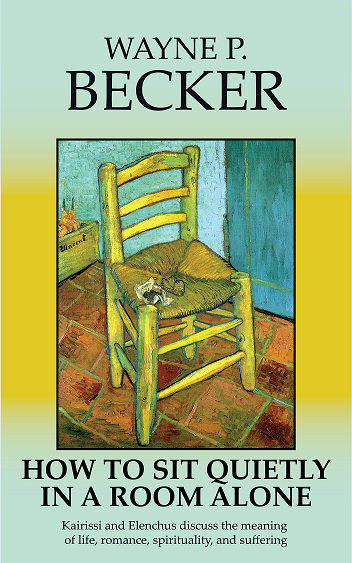
|
Eckhart Tolle: “You're in a room, you’re facing a wall, just sitting, and then you observe your mind, what it comes up with, and you learn to ‘just be with what is.’ This simple Zen meditation, some would say, is the most difficult meditation - just sitting and being with what is.”
|
|
In the school of Zen, they have a meditation called 'sitting.' No structure whatever. All they say is 'sit and be with what is.'
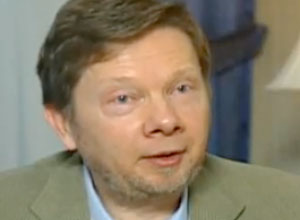
the following is a summary of hours of lecture, a rough transcription, of Eckhart Tolle's public discussion, “Living a Life of Inner Peace"
Sometimes in Eastern places of meditation there are visiting Westerners and sometimes the Easterners are very impressed by the Westerners, they can sit still for long periods of time, and there’s so much will-power – like holding a lid on a boiling kettle – and they sit there, and they’re showing everybody how great they are in their meditation, and you can see, or sense, there’s a lot of “wanting” there, there’s a lot of force behind it, and that’s not it. There’s no discovery of “inner space” there.
“Directing attention” is what’s needed. “Where is your attention?” For most people their attention is almost completely absorbed by thought-activity. They are so identified with the streams of thoughts in the head that they’re not looking for meditation or for anything else because, for them, there is nothing else. They are “the voice in the head,” as far as they’re concerned. They don’t know there’s a deeper dimension as it’s totally obscured by the chattering “monkey mind.” This incessant thinking becomes the ego, which means that thinking is invested with a sense of self. This is the “false self.” This is the normal human condition of unenlightenment.
All of this mind-conditioning that is infused with “self” causes suffering in one’s life. Eventually, this becomes one’s pathway to “salvation” - to enlightenment, which is to realize the “sacred inner life” of the soul - as the suffering, stress, and unhappiness begins to “crack” or “dissolve” the ego, and then, in a desperation to find peace for one’s mentally tortured life, other options are finally considered. Slowly, one might catch a glimpse of the “inner life,” attention is directed, more and more, to the “true self.”
The purpose of meditation practices is to draw one’s attention to where the mind is focused. The purpose of meditation is to realize how the “thoughts in the head” run one’s life; that, because of many years of mental conditioning, the thinking controls us and runs our life, and that we are not in control of these enslaving thoughts.
A discomfort may arise during meditation; or irritation arises, or impatience arises, or any kind of mind-conditioning arises. And you can learn from this, simply, to be with it, whatever the form of this moment takes; for example, the form of a pain in the knee. You accept the form of this moment. And this is why in Zen, the school of Zen, they have a meditation called “sitting.” No structure whatever. All they say is “sit and be with what is.” And you sit for hours and be with what is – that’s the Zen meditation.
And then they put you in a room, you’re facing a wall, and they open a window, and the cold winter air comes in, and you sit there shivering, and you be with what is. And then you observe your mind, what it comes up with – “what am I doing here, o.m.g. this is so stupid, what’s the point of all this, I could be home in a warm bed” – and then you see what arises in your mind, and you be with that. And you don’t say, “oh, I mustn’t have these thoughts,” you just be with what is. This is the Zen meditation, and they don’t even call it meditation, just “sitting.”
This is instruction on how to live - to be with what is - because “what is” is the way it is, and to fight that is absurd. And so this is what you learn in this simple Zen meditation, and some would say, the most difficult meditation. Just sitting, and being with what is.
This meditation has no specific meditation object, except to be with whatever condition arises this moment, or “what is” during the meditation. The condition may be internal: an emotion, a thought, a feeling, a physical sensation; or it may be external: cold air, warm air, noises around you, disturbing noises in the distance. This Zen meditation is a practice for the real world, for life as it must be lived, in all its variations.
Whatever condition comes is incorporated into the meditation, so you can never say, “I can’t meditate because this or that is happening.” Well, it’s part of the meditation. “You can’t say I can’t meditate because the children are screaming” – be the “space” for the noise around you. This meditation prepares you to be “present” in the midst of the chaos of life; whatever arises is part of the “is-ness” of life. You accept whatever arises. This does not mean that you become powerless. Just the opposite. You become the expression of enormous power. It is the power and intelligence of Universal Consciousness and Life itself; which can then act and enter the world through you.
The secret of Zen is “to be with what is,” to be totally “present” in whatever arises. When you are aligned with “the present moment,” you are in a state of continual meditation. And when you are in that state of alignment, “you are the spiritual Master.”
Some people think you need a lot of knowledge or years to be a spiritual teacher, but all you need is to be one with “the present moment,” which is alignment with life and with the mind of God. And then, because you are an “open channel,” whatever is needed in a situation, the answer will come through you, from Universal Intelligence.
And so, the reality is, you yourself are not the spiritual teacher. And if someone says, “well, I’ve studied all these years, I’ve practiced this and that, and now I am ready to be a spiritual teacher” – no. This is a sign that you are not ready because you are not an “open channel,” but a voice for the ego. The best qualification for being a Master is to feel that you’re not ready and that you don’t know anything; you have nothing to say and nothing to teach. This should be the introductory disclosure to any lesson you might offer others.
Editor’s note: I’ve created a special sister-article for the above. See it on the “Surrender and Acceptance” page. It seems to me that the greatest misconception of “be with what is” and “surrender and acceptance” is the notion that one must become a doormat to the world and just allow everyone to walk all over you. This is utterly wrong. I clarify this error in the related writing. As Eckhart says,
“You accept whatever arises. This does not mean that you become powerless. Just the opposite. You become the expression of enormous power. It is the power and intelligence of Universal Consciousness and Life itself; which can then act and enter the world through you.”
|
did you catch it? - sitting quietly in a room alone is just about the most difficult thing you can do
Why is sitting quietly in a room alone so difficult?
To answer this, first consider how people will do almost anything to avoid being alone with themselves: the mall-shopping, the bar-hopping, the string of sexual conquests, too much work, too much tv, too much video-gaming, too much drinking, too much reading – we could go on.
None of these activities, pursued in moderation, at the right time, is necessarily a problem and might be fine, but it all becomes a giant problem, a pathway to insanity, when we can’t face ourselves.
like holding down a lid on a boiling kettle
Many of us, schooled in a can-do spirit of grit and determination, want to get in there and show’em how it’s done. We believe we can do this “sitting thing" with the best of them. But that’s not how it works. Peter Russell said it well with, we must “relax into the resistance,” it must be an exercise of “ease itself.”
.PNG)
It’s much easier for an energetic young person to stay clear of the quiet room. Many years ago I bought a house in a big city with a restful and quiet backyard-porch and garden. When I moved in, I still recall saying to myself, “Well, this will be a nice place-to-escape out here for a cool drink on a summer day.” However, some years later, when I sold the house, I sort of gasped to realize that, in all of my time there, I’d spent, maybe, a total of five or ten minutes of peace-and-quiet on that porch.
But when we enter old age, it’s different. We’re no longer in the “empire-building” phase of life, nor do we have the energy to work long hours. Our options scale down. We don’t go out as much anymore, and now a visit to the narrow confinement of a secluded porch or small room becomes more-or-less a required activity. And then, finally alone, we begin to understand what we were avoiding all those years. We don't like it.
It can be frightening; and to do this gracefully in a clear-eyed way, without reaching for a bromide, is the most difficult thing that we've ever done.
|
Editor’s note:
In my opinion, Eckhart Tolle is the best modern explicator of Zen philosophy, making it generally accessible – as mere words might avail.

|
|
coming to terms with our most basic fear
The Course In Miracles often states that one’s anger, depression, annoyance – or any other aspect of negative energy – represents some form of fear. Fear is the apprehension or dread of loss.
I was able to understand the Course’s dictum in many areas of my life, but at times it didn’t ring true. I might be feeling annoyed or angered by some act of incivility, but, I would ask myself, how does this relate to fear? At those times, I didn’t feel particularly fearful about anything, nothing I could see. It didn’t make sense that fear might lurk behind most every bad feeling.
But then I suddenly saw, and all became clear. Many times the fear we experience is not about losing something at the surface of life. I brought to mind a principle which I’ve written about many times, that, the ego in its terrors will subliminally chant, not just that “I don’t have enough,” but “I am not enough.” This latter holds the key. In a hot moment of clarity I saw that my anger or annoyance often devolved to a threat against my essential identity, a fear of “not being enough.”
We’ll need to peel back the layers of repression and defense-mechanism to see what’s really going on, but it’s there. How does it work? Variously, but often the attack centers about our own sense of being “right” or a “good person.” If this is challenged, even slightly, by some untoward comment, or even by a report of what someone did to someone else, we can feel threatened. Our belief-system concerning our own ego-image stands in the balance. We’ve identified with being “right” and a “good person.” We try to find our significance and value in this contrived image - it is the "false self."
Not to say, of course, that it's improper to desire being right or good, as they’re decent goals, of and by themselves; but it all becomes wrong if we create a belief system out of them. We can then become unwarrantedly frightened of the loss of essential self - causing us to spring to defend ourselves with ego-repair mechanism, in the form of anger, annoyance, impatience, or the like.
Editor’s note: Again, what’s wrong with being right or a good person? Nothing, but we're not to create an image of these as substitute for our true selves. The true self is the soul, linked to God, and when we access its energy, in a natural way, we do so without identifying with it as if it were an “other.” Properly construed, we cannot identify with it, because we are it.
|
|
“I am never upset for the reason I think”
This masthead quotation from the “Course In Miracles” continues the discussion in the inset-box just above.
The Course goes on to offer a reason: “I am never upset for the reason I think because I am constantly trying to justify my thoughts. I am constantly trying to make them true.”
And what is the purpose of this constant justification of thoughts?
The constant justification by the ego within, tormenting us -- not the true self – results in making "all things enemies." And why? - "so that my anger is justified and my attacks are warranted.”
an attempt to dehumanize
This is the real reason why, as discussed on the “Evil” page, also on the "levels of consciousness" page, before any untoward act is committed, be it minor incivility or gross atrocity, there will be some attempt to dehumanize the victim. This is what name-calling, gossip, and other forms of misrepresentation is about.
And why do we try “to make all things enemies”? It’s part of the individuation process, by which we become persons in our own right. It’s why we came to this world of duality and opposites, and it’s not a pretty process; unfortunately, evil thoughts will get the job done as well as anything.
The ego needs enemies because they’re very handy in terms of defining oneself by way of contrast. It’s “me against them,” and in this “back-and-forth" our sense of personhood is strengthened.
not a pretty process at all
This is why Spirit Guide Abu is on record to assert that, fundamentally, it is our “response” which is operative here: “That is the nexus of the process of individualization.” Further, he comments, “Great agony, great hatred will also individualize.”
it's the response that sparks personhood into being
Consider well the dynamic. It is our response itself, even though it might be a vicious one, which is so efficacious in turning us into a person. When we play off the constant stresses of living in this world, our spirits are fashioned into something individualized. Granted, the process cannot end here, with ourselves as angry and hating persons, but it’s only a first step in our spiritual evolution. Becoming a good person is a level or two beyond, and might not even happen in this world. Planet Earth is cause for many sufferings, and we’ll be glad to leave it behind, but it’s custom-made and does a very good job for one thing, for what it was designed to do - turning us into individualized persons.
the spotlight within
But the “Course In Miracles” would hope to lift us out of this low-level classroom and speed up the process of our becoming good persons. It does this, initially, by encouraging us to become aware of our own thinking and just how destructive it is. When we shine a spotlight on our thinking, we will be shocked, and dismayed, to witness how often, even subtly, we try to make everyone and everything into an enemy.
defending a thought system
The Course instructs that, when we do this, we’re attempting to “defend a thought system,” a belief system. What does this mean, “defend a thought system”?
turning everything into a 'me'; but at least I'm becoming a 'me'
Much of the individualization process centers about identifying with the thoughts in our head. We think that these thoughts are the “real me,” but this is not so. Our thoughts become a “false self” to us. However, a “false self,” all of the raucous thoughts in the head, is valuable to us, in the short term. This is so because, while the “false self” might be false, it is nevertheless a “self,” and that’s what is needed for us during our spiritual “kindergarten” years. The “false self” is like “training wheels for us, along the way to becoming a full-fledged person in our own right.
All around us, we see people defending thought systems, belief systems. This occurs not just in the classic cultish examples focused upon politics, academia, religion, or science, but in private opinions and ways of looking at life.
notice the bristling
Notice how people begin to bristle if you disagree with them in the slightest. They think they’re defending an opinion or idea, but what they’re really doing is defending a fragile incipient “self” that has identified with the thoughts in the head. People become angry when a contrary view is presented because they feel threatened – the ego feels threatened – and is struggling to survive in the onslaught of new information.
All this is baked into the cake of the Course’s declaration, “I am never upset for the reason I think.”
|
|
the purpose of the brain is to filter out, from universal consciousness, anything not correlating with the body’s perspective; in this ‘step-down transformer’ process, separate egos, with separate personal identities, emerge
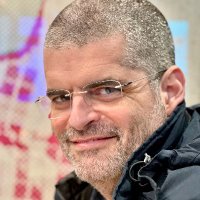
Dr. Bernardo Kastrup, PhD philosophy, PhD computer science, for many years worked at CERN, the large hadron collider in Geneva.
“… the function of the brain is to localize consciousness, pinning it to the space-time reference point implied by the physical body. In doing so, the brain modulates conscious perception in accordance with the perspective of the body.
a brain that filters implies the existence of unbound mind, a universal consciousness
"When not subject to this localization and modulation mechanism, mind is unbound: it entails consciousness of all there is across space, time, and perhaps beyond. Therefore, by localizing mind, the brain also ‘filters out’ of consciousness anything that is not correlated with the body’s perspective… like a radio receiver selecting [a particular station], among the variety [with] all other stations being filtered out and never reaching the consciousness of the listener…
"[T]he filter hypothesis implies that consciousness, in its unfiltered state, is unbound. As such, consciousness must be fundamentally unitary and non-individualized, for separateness and individualization entail boundaries.
Editor’s note: Father Benson from the afterlife speaks of a being, formerly mortal, five billion years old, so advanced as to enjoy awareness of all life-forms in the universe; in this, we see the future of the ‘unfiltered’ mind. Read More on the “500 hundred tape-recorded messages from the other side” page.
the filtering brain creates the illusion of separateness, of disconnected personal egos
"The emergence of multiple, separate and different conscious perspectives or egos, is a consequence of the filtering and localization process: different egos, entailing different perspectives on space-time, retain awareness of different subsets of all potential subjective experiences, the rest being filtered out. It is the difference across subsets that give each ego its idiosyncratic vantage point, personal history, and sense of personal identity.
Editor’s note: A brain designed to filter, and reduce to a trickle, experience does not substantively support a theory of reincarnation which exalts much experience. We do not come to this planet to gain experience, as such, but to individualize, to transform one’s tiny sub-set of universal consciousness into a personal ego. With this, we become ready for what comes next in the afterlife, even if we are not yet “good” persons, which can be accomplished later, but only after one becomes a person in one’s own right. Read More on this need for individualization.
"The subjective experiences that are filtered out become the so-called ‘unconscious’ mind of the respective ego. Since each ego allows in only an infinitesimally small part of all potential experiences … the ‘unconscious’ minds of different egos will differ only minimally… As such, the filter hypothesis, unlike materialism, predicts the existence of a ‘collective unconscious’; a shared repository of potential experiences that far transcends mere genetic predispositions of a species…
the likely origin of the mystical experience
"[A]nd most importantly, the filter hypothesis predicts that one can have experiences that do not correlate with one’s brain states. Since here the brain is seen merely as a mechanism for filtering out experience … when this [filtering] mechanism is interfered with so as to be partially or temporarily deactivated, one’s subjective experience could delocalize, expand beyond the body in time and space, and perhaps even beyond time and space [giving rise to what is called the mystical experience]…”
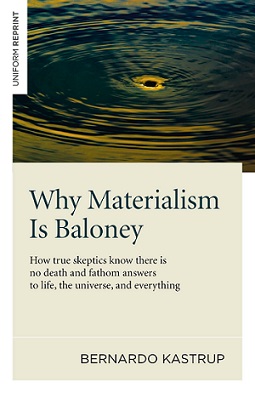
READ MORE of Dr. Kastrup's work on the “quantum mechanics” page
|
|
everything the ego does devolves to one central pathology
All this talk of the Ego and its ensuing widespread calamity may seem overdone. Therefore, allow me another attempt to explain the pervasive nature of its sordidness confronting every human being.
What do the following 10 examples have in common?
(1) the elderly lady, visibly frightened of new information which might threaten her view of a particular god or goddess rescuing her upon transition to the next world;
(2) screaming fans, shouting with hysteria, hoping to touch, or even glimpse, an adored celebrity;
(3) billionaire corporate heads employing new technology to increase surveillance on a populace, thereby diminishing rights to privacy;
(4) national leaders, with big sloppy grins, posing as benefactors to the country’s interests, while undermining civil liberties, the rule of law, and taking to themselves more power;
(5) supervisors or fellow co-workers seeking to deny promotion or commendation, though you’ve earned it and are the best choice for the new position;
(6) social-media platforms which censor free speech because of "misinformation," meaning, it doesn't conform to a totalitarian agenda;
(7) materialistic scientists who repress, ignore, or otherwise vilify the "scientific evidence for the afterlife";
(8) a friend, lover, or family member who insults you, slants a story, attacks you, cheats you, because they disagree with, and are threatened by, your new-found beliefs.
(9) the neo-Postmodernist, the delusional “woke” adherent, occupying the lowest level of consciousness, arrogantly and vacuously proclaiming that rationality itself is part of “white man’s” oppression; that, even to be on time for work is a “white thing”;
(10) the soldier, part of an invasion force against a peaceful people, firing on, murdering, civilians because it’s his “duty” to “follow orders” of his imperialistic superiors.
We could go on listing many more: the gossip in your neighborhood who stands by her window, judging and condemning, trafficking in the mundane details of others; the college instructor who ridicules, and punishes with lower grades, those who disagree with his totalitarian leanings; the so-called news-reporter, piously claiming to have entered her profession to “make a difference,” incessantly offering selective and screened factoids to support a hoped-for Orwellian dystopia; the suicide-bomber, or the mad driver barreling into a crowd of civilians, or the shootist, seeking for publicity, or revenge; the high-school friend, once a confidante, but suddenly counting you an enemy when she veers off into new philosophical moorings; the martinet husband, psychologically, or otherwise, abusing a wife whom he does not love yet will not allow to leave his fiefdom.
What is the common thread?
In each case, a needy ego has identified with some power-structure, some external augmentation, some strong “father figure” to the inner child; an adoption of surrogate life, a face-saving production, a seeking to enhance oneself, to make oneself “more” and “above,” to feel important and a “somebody”, a propping up and bolstering, an assuagement of underlying fears of “not making the grade,” of “I am not enough,” leading to a surrendering of autonomy and critical faculties, a victimhood pathology of linking oneself to some external image of authority or purported salvation.
According to the great psychologists, in its deepest writhings, all of these examples represent the fear of death on display. In each case, a perceived locus of one's life and essence, one’s “center of being,” lies outside oneself, stands subservient to some icon of imagined greater energy, wisdom, or value. In other words, in all this dysfunction there is no sense of having been "made in the image," of “being enough,” no personal view of the limitless "inner riches," one's divine heritage as "spark struck-off from God." As such, this deficit leads to servility, to existential crisis, to forms of insanity. And therefore nearly 100% of the denizens of planet Earth are engaged in some form of the above cultism.
|
more than drinking the koolaid
The long reach of cultism encompasses much more than crackpot churches. The root idea of cult offers the sense of "cut." This core concept of "cut" leads us to images of refinement and refashioning and, by extension, development, control, pattern, order, and system.
Cultism as systemization finds a ready home in religion and philosophy which seek to regulate and redistill the patterning and ordering of ideas. However, in a larger sense, the spirit of cultism extends to every facet of society. We find it scheming and sedulously at work in politics, academia, family, corporations, entertainment, science, artistry – anywhere power might be gained by capturing credulous and fear-based minds.
See the “cultism” page for a full discussion.
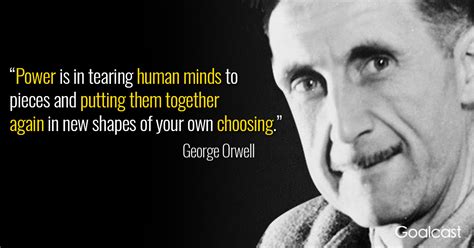
|
I submit to you, every insult, abuse, affront, contempt, disrespect, misrepresentation, aggression, assailment, invasion, violation, trespass, usurpation, infringement, conflict, and war – in the history of the world, and your own personal history -- have resulted from egos, at the expense of others, attempting to feel better about themselves, pursuing to quash the sense of inner neediness, of “I don’t have enough” because “I am not enough.”
every ego wants something from you
What does it want?
It wants to use you to feel better about itself, to fill up the emptiness inside. It will attempt to accomplish this make-over by (1) comparing itself to you, finding some metric by which it can judge itself as superior; (2) deriving pleasure from you, an effort to cloak the pain within; (3) ruling over you, power-and-control measures, to enhance and propagandize itself; (4) minimizing, discounting what you represent in order to aggrandize its distorted belief system about how life works; alternatively, if demonizing doesn’t succeed, it will (5) surrender to you, call you a genius or a god, by which subservience it hopes to find security and safety under the protective mantle of a “strong father figure.”
further distillation
Can we, even more, reduce all of the above to common element?
The ego, at a deeper level, is driven to create a perception of itself as “other.” This generalized sense of “otherness” is then leveraged into a “me against them” lens of looking at the world. And it’s not just a contrariness toward other people. If others aren’t around, or even if they are, the ego can make us feel estranged from life itself and, of course, God, as well, as we blame, and set ourselves against, these for perceived unfairness.
Why is this important to the ego? According to ancient Spirit Guides, we come to this world for one primary reason: to individuate, to become persons in our own right; all other aspects of development, for the moment, are secondary.
The ego will reconfigure memories and current sensations to emphasize “otherness.” Much of this reformulation can be very unpleasant to contemplate, but it does accomplish one thing: even though at the quantum level we are connected to all, at the surface of personality “otherness” creates a stand-alone psychological entity that becomes the perception of “I”, which is the very definition of ego.
Editor’s note: Concerning the above “10 examples,” each of these represents a certain unsavory aspect of the dark side of human nature. But this skews the picture. The dysfunctional ego also operates in the arena of heroic service and commendable, stalwart mettle.
I am thinking of the celebrity artist, athlete, singer, politician or other notable who publicly dedicates his or her life to good works as a result of purportedly drawing strength from a patron saint, religious icon, or savior-god. The ensuing good works might be larger-than-life, consummated even in the face of great privation and adversity. All of which is meant to proclaim to the world, “I do all this by the power of my relationship to said patron saint, religious icon, or savior-god.”
But, is this reality? How are we to view such valorous and epic conduct? Does it happen by way of aligning one’s person with an external divinity?
We would do well to recall that any number of non-religious “secular saints” might be brought to our attention who have nobly, in a lion-hearted way, offered charitable service, even to the point of death. One example immediately comes to mind: Dr. Viktor Frankl, in the concentration camps. He accepted the task of encouraging other inmates, despite near-starvation and often-beatings by the guards. He served the contagious typhoid dying, and, more than once, refused opportunity to escape the camp in order to remain with the suffering.
The dysfunctional ego is led by its foundational premise, “I don’t have enough” because “I am not enough.” As such, it looks for salvation from an outside source. This is pathological and takes us in the wrong direction, far from sacred destiny of living from one’s sacred center, the true self, one’s inner connection to God.
We are not to conduct ourselves as little children, living under the mantle of a “strong father figure,” a patron saint, religious icon, or savior-god.

We are to open our eyes to the inner riches, the innate “made in the image” reservoir of strength, available to all of us as sons and daughters of God.
|
|
‘notice the disorder’
Krishnamurti frequently admonishes “notice the disorder,” do not fight or condemn what is seen with the inner eyes but simply acknowledge.
But, exactly which aspect of the disorder are we to focus on?
We are not to focus on the disturbing “images” themselves. These can be quite horrid, and we don’t want to encourage or fix these upon the memory. Yet, while we do not like their presence, we are not to “fight” these images. How to handle this?
I have learned, by trial and error, how this process is to work. Try it for yourself and find the right way, for you, to mentally apprehend. Instead of “fighting” the image, or saying “I ought not to be seeing this in my head” -- which creates a sense of conflict and strengthens the ego – try to switch one’s focus to the underlying energy. Yes, there may temporarily be a sordid image by which the ego torments, but can you “go beneath” the image and focus on the energy that’s propping it up? You’ll need to work with this, trying different approaches, to see what I mean, but, when it works for you, you will easily slip into a mode of simply “noticing the disorder” - not the image but the underlying energy.
Also, something that works for me, is to focus on the energy in one's hands. This draws attention from the sordid mental image and allows relief.
This, I believe, and sense, is an incredibly important mental skill. The mind serves us in many ways but, one primary way, is to become for us a virtual “radar screen” which will immediately evaluate all energies that cross its field of purview. When we become skilled at this, we will instantly perceive an energy that is “out of alignment” with the spirit of God.
The rational part of the brain is not involved at all. It’s pure intuition at work. And now we’ve entered the realm of which the apostle Paul spoke concerning those who “live in the Spirit.” These, he said, judge all things, discern all things. And it’s done instantly, without the rational mind making a decision. Instead, the mind, now sensitized to alien-ungodly energies, automatically flashes a warning on the “radar screen” of the spirit-led mind.
And this entire process of discernment is developed by “simply noticing the inner disorder.” One’s ability in this area of expanding consciousness will just grow and grow, unlocking more and more of the soul’s inner riches. As Kairissi joked, “next thing you know, you’re 5 billion years old and aware of every life form in the universe.”
|
|






